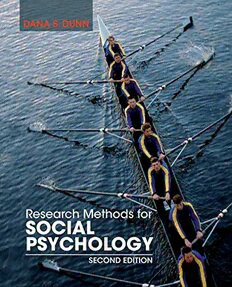
Research Methods for Social Psychology PDF
Preview Research Methods for Social Psychology
FLAST013GXML 10/26/2012 10:18:25 Page16 FFIRS3GXML 10/26/2012 9:55:9 Page1 Research Methods for Social Psychology Second Edition Dana S. Dunn FFIRS3GXML 10/26/2012 9:55:9 Page2 VP&ExecutivePublisher: JayO’Callaghan SeniorAcquisitionsEditor: RobertJohnston EditorialAssistant: MauraGilligan AssistantEditor: BrittanyCheetham SeniorMarketingManager: MargaretBarrett AssociateProductionManager: JoycePoh ProductionEditor: JoleneLing ProductionManagementServices: ThomsonDigital Designer: KenjiNgieng CoverCredit: #Purestock/GettyImages,Inc. Thisbookwassetin10.5/13pt,MinionRegbyThomsonDigital.Coverandtextwereprintedandboundby MalloyLithographers. Thisbookisprintedonacidfreepaper. Foundedin1807,JohnWiley&Sons,Inc.hasbeenavaluedsourceofknowledgeandunderstandingformorethan 200years,helpingpeoplearoundtheworldmeettheirneedsandfulfilltheiraspirations.Ourcompanyisbuiltona foundationofprinciplesthatincluderesponsibilitytothecommunitiesweserveandwhereweliveandwork.In 2008,welaunchedaCorporateCitizenshipInitiative,aglobalefforttoaddresstheenvironmental,social,economic, andethicalchallengeswefaceinourbusiness.Amongtheissuesweareaddressingarecarbonimpact,paper specificationsandprocurement,ethicalconductwithinourbusinessandamongourvendors,andcommunityand charitable support. For more information, please visit our website: www.wiley.com/go/citizenship. Copyright#2013,2009JohnWiley&Sons,Inc.Allrightsreserved.Nopartofthispublicationmaybereproduced, storedinaretrievalsystemortransmittedinanyformorbyanymeans,electronic,mechanical,photocopying, recording,scanningorotherwise,exceptaspermittedunderSections107or108ofthe1976UnitedStatesCopyright Act,withouteitherthepriorwrittenpermissionofthePublisher,orauthorizationthroughpaymentofthe appropriateper-copyfeetotheCopyrightClearanceCenter,Inc.222RosewoodDrive,Danvers,MA01923,website www.copyright.com. Requests to the Publisher for permission should be addressed to the Permissions Department, John Wiley & Sons, Inc., 111 River Street, Hoboken, NJ 07030-5774, (201)748-6011, fax (201)748-6008, website http://www.wiley.com/go/permissions. Evaluationcopiesareprovidedtoqualifiedacademicsandprofessionalsforreviewpurposesonly, foruseintheir coursesduringthenextacademicyear.Thesecopiesarelicensedandmaynotbesoldortransferredtoathirdparty. Uponcompletionofthereviewperiod,pleasereturntheevaluationcopytoWiley.Returninstructionsandafreeof charge return mailing label are available at www.wiley.com/go/returnlabel. If you have chosen to adopt this textbook foruseinyourcourse,pleaseacceptthisbookasyourcomplimentarydeskcopy.OutsideoftheUnitedStates,please contactyourlocalsalesrepresentative. LibraryofCongressCataloging-in-PublicationData Dunn,Dana. ResearchmethodsforsocialPsychology/DanaS.Dunn. p.cm. Includesbibliographicalreferencesandindex. ISBN978-1-118-40605-2(pbk.) 1. Socialpsychology–Research–Methodology. I. Title. HM1033.D8622013 302—dc23 2012026717 PrintedintheUnitedStatesofAmerica 10987654321 FTOC3GXML 10/26/2012 10:2:33 Page3 Table of Contents PrefacetotheSecondEdition xi Acknowledgments xiv AbouttheAuthor xv 1 StudyingSocialPsychology 1 IntroducingandDefiningSocialPsychology 1 EstablishingCausality:TheImportanceofExperimentationinSocialPsychology 3 LevelsofExplanation:SocialPsychology’sRelationtoOtherFieldsofInquiry 5 PersonalityPsychology’sRelationtoSocialPsychology 7 TheScientificMethod:DoingSocialPsychology 8 Why?SocialPsychologyisSocial 11 SocialThought 12 SocialInfluence 12 SocialConnections 12 Where?TheLabandtheField 13 TheLab 13 TheField 13 OneMoreDistinction:BasicandAppliedResearch 15 SocialPsychologistsToday 16 ActiveLearningExercise1A:LearningAboutActiveSocialPsychologists 16 LearningResearchMethodsforSocialPsychology 18 ActiveLearningExercise1B:PlanningaResearchProjectinSocialPsychology 18 Exercises 19 2 DevelopingResearchTopicsinSocialPsychology 20 TheScopeofSocialPsychology 22 TraditionalTopicsandNewAvenuesforResearch 23 ExtendingEarlierResearch 26 FindingaResearchQuestion 26 Self-Reflection 26 ExplorebutVerifyHindsight 27 FTOC3GXML 10/26/2012 10:2:33 Page4 iv TableofContents YourCampus 27 YourCommunity 28 LooktotheMedia 29 TheWiderWorld 29 AskanExpert 30 TheWorldWideWeb 30 WatchOtherPeople 31 OtherSourcesforResearchIdeas 31 ActiveLearningExercise2A:DevelopingTopicIdeasbyBrainstorming 32 ActiveLearningExercise2B:KeepingaSocialPsychologyLog 33 SearchingtheSocialPsychologicalLiterature 34 SearchingDatabases 36 SearchingtheLibraryCatalog 39 SeekingHelp:SpeaktoReferenceProfessionals 39 ActiveLearningExercise2C:MaintainingaBibliographyandOrganizing Sources 40 ReadingSocialPsychologyResearch 41 BorrowingIdeasfromPublishedSocialPsychologyExperiments 43 Exercises 44 3 EthicalIssuesinSocialPsychologicalResearch 45 Milgram’sObedienceResearch 47 OtherEthicallyChallengingExamples 50 TheProblemofDeceptioninSocialPsychologyExperiments:BalancingBenefits andCosts 51 ArgumentsforUsingDeception:SomeBenefits 53 ArgumentsAgainstUsingDeception:TheCosts 55 TheSpecialRoleofConfederates 56 LabelsDoMatter:Participants,NotSubjects 57 InstitutionalReviewBoards 59 ActiveLearningExercise3A:ForminganIn-ClassIRB 61 ActiveLearningExercise3B:CompletinganIRBForm 62 InformedConsentisEssential 63 Confidentiality 64 ObtainingInformedConsent 65 ActiveLearningExercise3C:CreatinganInformedConsent FormforYourProject 66 EthicalIssuesandFieldResearch 68 SharedVirtues:EthicalTreatment,Education,andScience 69 ALastWordonEthics? 70 Exercises 71 FTOC3GXML 10/26/2012 10:2:33 Page5 TableofContents v 4 BasicExperimentalDesign 72 TheLogicofExperimentation 73 TheAdvantagesofExperiments 76 WhyExperimentsMatterinSocialPsychology 77 TurningaResearchQuestionintoaHypothesis 77 OperationalDefinitionsinSocialPsychologicalResearch 78 ActiveLearningExercise4A:WritinganOperationalDefinition 80 IndependentandDependentVariables 81 ActiveLearningExercise4B:IdentifyingIndependentandDependent VariablesinSocialPsychologyExperiments 82 DoingRandomizationinSocialPsychologyExperiments 83 IssuesofError 83 SamplingandRandomization 87 ActiveLearningExercise4C:PerformingRandomAssignmentandRandom Selection 89 CommonExperimentalDesignsinSocialPsychology 92 Between-SubjectsResearchDesigns 92 Within-SubjectsResearchDesigns 98 ActiveLearningExercise4D:RecognizingMainEffectsandInteractions 99 JoiningBetween-andWithin-SubjectVariables:MixedDesigns 104 DesignMatters 104 Exercises 105 ActiveLearningExercise4BAnswers 105 Table4.6Answers 105 5 AlternativestoExperimentalResearchinSocialPsychology 106 LeavingtheComfortoftheLab:ProblemsandProspects 109 ObservationalResearch 110 ActiveLearningExercise5A:DesigningandConductinganObservationalStudy 111 CorrelationalApproaches 112 ActiveLearningExercise5B:ConductingaCorrelationalStudyonPersonality 115 Quasi-ExperimentalResearchDesigns 117 NonequivalentGroupDesigns 118 TimeSeriesDesigns 120 SurveyResearch 123 ApproachestoSurveyingOpinion 123 ExperienceSamplingMethodsandDiaryApproaches 124 ActiveLearningExercise5C:ConductinganESMStudy 125 DearDiary:AnExample 126 Internet-BasedResearch 127 InternetEthics 128 FTOC3GXML 10/26/2012 10:2:33 Page6 vi TableofContents Time,ParticipantLoss,andSamplingIssues 129 AnInternet-BasedExample:OnlineCharacterPre-andPost-September11,2001 131 ArchivalResearchandMeta-Analysis 133 SummarizingStudiesofSocialBehavior:Meta-Analysis 138 Conclusions 140 Exercises 140 6 DevelopingQuestionnairesandSurveys 142 CaveatEmptor:Letthe(Jam)BuyerBeware 143 TheObviousAdvantageofAskingQuestions 145 SamplingIssues 146 ProbabilityandNonprobabilitySamples 147 ScalesofMeasurement 149 NominalScales 150 OrdinalScales 151 IntervalScales 151 RatioScales 151 TypesofQuestions:Open-EndedandClose-Ended 152 Open-EndedQuestions 152 Close-EndedQuestions 154 TheMostCommonandUsefulNumericalScale:TheLikertScale 155 WritingClearQuestions 157 Phrasing 158 SequencingQuestions 163 BeingSensitive 165 LastWordsonWordingforQuestionnairesandSurveys 165 ActiveLearningExercise6A:WritingandRevisingQuestions 166 ActiveLearningExercise6B:PilotTestingQuestions 167 SocialDesirabilityConcerns,HaloEffects,andYea-Saying 167 WeLiketobeLiked 167 LikesorDislikesCanMatter 169 Yes,Yes,AThousandTimes,Yes 170 AnonymityorIdentity? 171 ABriefWordonSurveyDataCollection 171 QuestionnairesandSurveysasPrecursorstoExperiments 172 Exercises 173 7 IntroducingaDifference:IndependentVariables 174 ConceivingIndependentVariables 176 TypesofIndependentVariables 178 CanOneOperationalizationofanIndependentVariableRepresentAllPossibilities? 180 FTOC3GXML 10/26/2012 10:2:33 Page7 TableofContents vii ProvidingContextfortheIndependentVariable:Instructions 181 PlanforPiloting 182 DeliveringtheIndependentVariable 182 DeliveryviaAuthority:TheExperimenter 183 PersonalDelivery:ConfederatesandPeers 184 WrittenDelivery 185 OtherFormsofDelivery 185 OneMoreTime:Instruct,Repeat,andProbe 186 ActiveLearningExercise7A:DevelopingIndependentVariables 187 HowManyIndependentVariables?AReprise 188 IndividualDifferencesasIndependentVariables:ProspectsandProblems 188 VerifyingCauseandEffect:ManipulationChecks 189 ActiveLearningExercise7B:DevelopingaManipulationCheck 191 TheBestLaidPlans(andIndependentVariables) 192 PerformanInternalAnalysis 193 AskParticipantsButbeWary 194 Impact:IncreaseObviousness 194 ReconsidertheHypothesis 195 KeepaCausalFocus 196 Exercises 196 8 MeasuringWhatHappens:DependentVariables 198 BehavioralDependentMeasures 199 MeasuringWhatPeopleDo 202 MeasuringIntentionsandFutureCommitments 205 BehavioralMeasuresinDisguise:UnobtrusiveMeasures 206 ActiveLearningExercise8A:CreatingCreativeDependentMeasures 208 VerbalMeasures 209 VarietiesofVerbalMeasuresRevisited 210 SomeAdditionalVerbalDependentMeasures 214 OtherTypesofDependentMeasures 216 NonverbalMeasures 216 ImplicitMeasures 216 PhysiologicalMeasures 217 FalsePhysiologicalFeedback:TheBogusPipeline 219 NarrativeApproaches 219 SomePracticalIssuesforAdministeringDependentVariables 219 ActiveLearningExercise8B:DevelopingDependentVariables byLookingtotheLiterature 221 ReliabilityandDependentVariables 222 Exercises 223 FTOC3GXML 10/26/2012 10:2:33 Page8 viii TableofContents 9 ValidityandRealisminResearch 224 TrustingResearchEvidence:DemonstratingInternalValidity 226 GeneralThreatstoInternalValidity 228 Reprise:WaystoEnhanceaStudy’sInternalValidity 231 GeneralizingtoOtherSettings:ExternalValidity 231 ExternalValidityviaReplication 232 CollegeSophomoresasThreatstoExternalValidity 233 ContextMatters 234 EnhancingExternalValidity 235 InPraiseofExternalInvalidity 236 TheSocialPsychologist’sChallenge:Trade-OffsBetween InternalandExternalValidity 237 ActiveLearningExercise9A:EvaluatingYourProject’s InternalandExternalValidity 238 MakingItReal:Mundane,Experimental,andPsychologicalRealism 239 ActiveLearningExercise9B:EnhancingMundaneand ExperimentalRealism 242 (Re)ConsideringConstructValidity 243 BeyondConstructValidity 244 ValidityandRealismviaReplication 244 Exercises 245 10 ConductingSocialPsychologyExperiments:PracticalMatters 246 SettingtheStage 248 DeceptionRevisited:ThinkCarefullyBeforeYouDecide toDeceiveParticipants 249 RecruitingParticipants 250 ActiveLearningExercise10A:ParticipantPools,Sign-upSheets, andGivingCredit 250 DemandCharacteristics 253 ReducingExperimenterBiases 254 ActiveLearningExercise10B:WritingaScriptforYourStudy 257 RecordKeeping 259 ActiveLearningExercise10C:CreatingaDataRecordSheet 260 ConductingaPostexperimentalInterview 262 OnTheRareOccasionWhenDeceptionIsNecessary 263 ActiveLearningExercise10D:CraftingaDebriefingProtocol 263 ActiveLearningExercise10E:WritingaDebriefingSheet 265 ClosingThoughts:PilotTestingandLong-TermChange 266 Exercises 267
